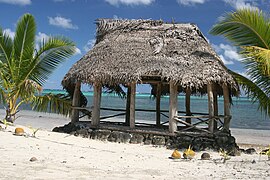Samoa
Samoa,[note 1] officially the Independent State of Samoa[note 2] and until 1997 known as Western Samoa (Samoan: Sāmoa i Sisifo), is a Polynesian island country consisting of two main islands (Savai'i and Upolu); two smaller, inhabited islands (Manono and Apolima); and several smaller, uninhabited islands, including the Aleipata Islands (Nu'utele, Nu'ulua, Fanuatapu and Namua). Samoa is located 64 km (40 mi) west of American Samoa, 889 km (552 mi) northeast of Tonga, 1,152 km (716 mi) northeast of Fiji, 483 km (300 mi) east of Wallis and Futuna, 1,151 km (715 mi) southeast of Tuvalu, 519 km (322 mi) south of Tokelau, 4,190 km (2,600 mi) southwest of Hawaii, and 610 km (380 mi) northwest of Niue. The capital and largest city is Apia. The Lapita people discovered and settled the Samoan Islands around 3,500 years ago. They developed a Samoan language and Samoan cultural identity.
This article is about the nation of Samoa. For the geographical region, see Samoan Islands. For the Samoan United States territory, see American Samoa. For other uses, see Samoa (disambiguation).
Independent State of SamoaMalo Saʻoloto Tutoʻatasi o Sāmoa
- 92.6% Samoans
- 7.0% Euronesians
- 0.3% Europeans
- 0.1% others[1]
- 97.9% Christianity (official)[2]
- 54.9% Protestantism
- 18.8% Catholicism
- 16.9% Mormonism
- 7.3% other Christian
- 97.9% Christianity (official)[2]
- 1.7% no religion
- 0.4% others[3]
14 June 1889
16 February 1900
1 March 1900
30 August 1914
17 December 1920
13 December 1946
1 January 1962
15 December 1976
4 July 1997
0.3
70/km2 (181.3/sq mi)
2018 estimate
$1.188 billion[6]
$5,962[6]
2018 estimate
$881 million[6]
$4,420[6]
![]() 38.7[7]
38.7[7]
medium
dd/mm/yyyy
left[d]
Samoa is a unitary parliamentary democracy with 11 administrative divisions. It is a sovereign state and a member of the Commonwealth of Nations. Western Samoa was admitted to the United Nations on 15 December 1976.[15] Because of the Samoans' seafaring skills, pre-20th-century European explorers referred to the entire island group (which includes American Samoa) as the "Navigator Islands".[16][17] The country was a colony of the German Empire from 1899 to 1915, then came under a joint British and New Zealand colonial administration until 1 January 1962, when it became independent.
Education[edit]
The Samoan government provides eight years of primary and secondary education that is tuition-free and is compulsory through age 16.[107]
Samoa's main post-secondary educational institution is the National University of Samoa, established in 1984. The country is also home to several branches of the multi-national University of the South Pacific and the Oceania University of Medicine.[108]
Education in Samoa has proved to be effective as a 2012 UNESCO report stated that 99 per cent of Samoan adults are literate.[109]
The Human Rights Measurement Initiative (HRMI)[110] finds that Samoa is fulfilling only 88.0% of what it should be fulfilling for the right to education based on the country's level of income.[111] HRMI breaks down the right to education by looking at the rights to both primary education and secondary education. While taking into consideration Samoa's income level, the nation is achieving 97.7% of what should be possible based on its resources (income) for primary education but only 78.3% for secondary education.[111]
Government
General information
13°44′42″S 172°13′03″W / 13.74500°S 172.21750°W


